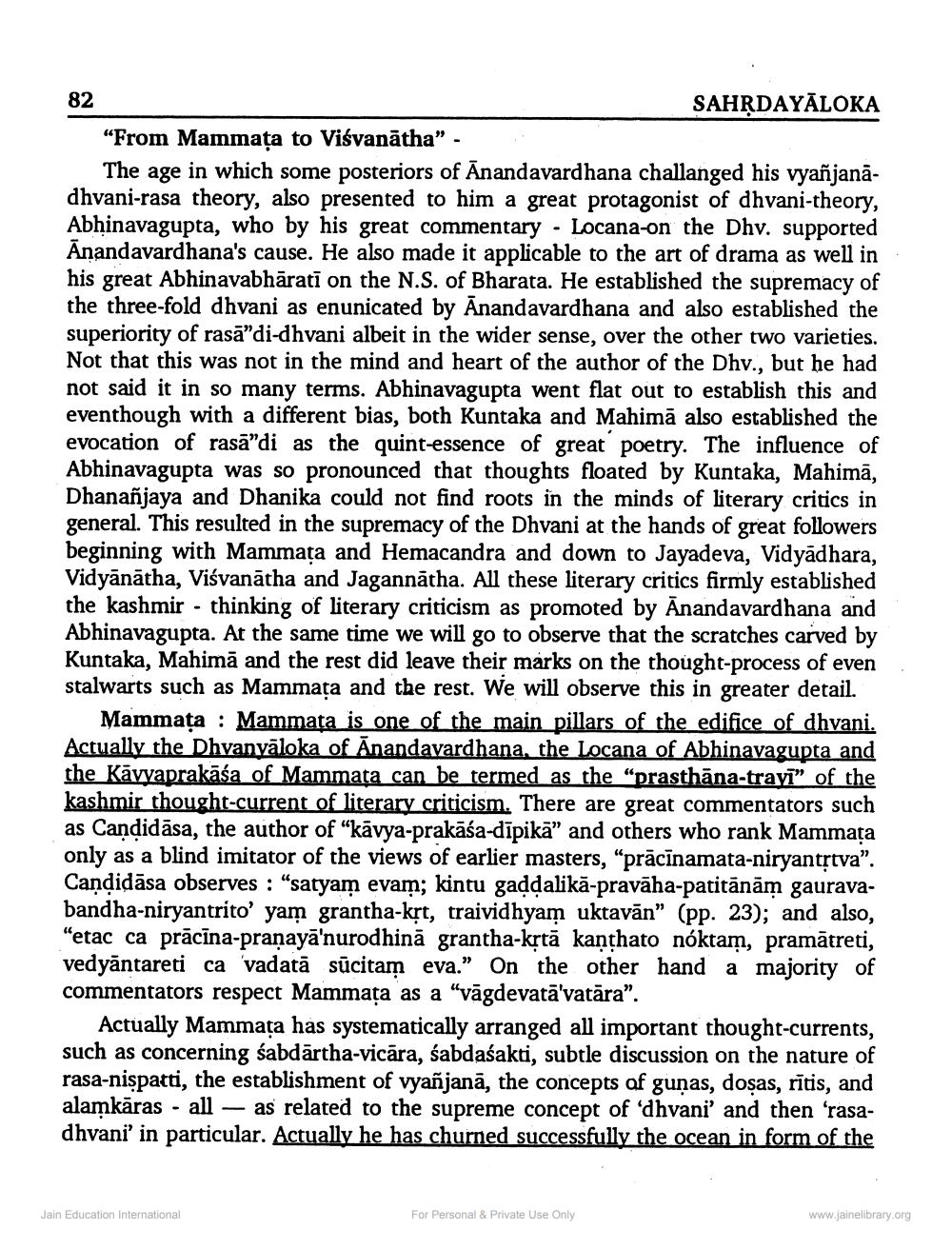________________
82
SAHRDAYĀLOKA “From Mammaţa to Viśvanātha".
The age in which some posteriors of Anandavardhana challanged his vyañjanadhvani-rasa theory, also presented to him a great protagonist of dhvani-theory, Abhinavagupta, who by his great commentary - Locana-on the Dhv. supported Anandavardhana's cause. He also made it applicable to the art of drama as well in. his great Abhinavabhāratī on the N.S. of Bharata. He established the supremacy of the three-fold dhvani as enunicated by Anandavardhana and also established the superiority of rasā”di-dhvani albeit in the wider sense, over the other two varieties. Not that this was not in the mind and heart of the author of the Dhv., but he had not said it in so many terms. Abhinavagupta went flat out to establish this and eventhough with a different bias, both Kuntaka and Mahimā also established the evocation of rasā”di as the quintessence of great poetry. The influence of Abhinavagupta was so pronounced that thoughts floated by Kuntaka, Mahimā, Dhanañjaya and Dhanika could not find roots in the minds of literary critics in general. This resulted in the supremacy of the Dhvani at the hands o beginning with Mammata and Hemacandra and down to Jayadeva, Vidyadhara, Vidyānātha, Viśvanātha and Jagannātha. All these literary critics firmly established the kashmir - thinking of literary criticism as promoted by Anandavardhana and Abhinavagupta. At the same time we will go to observe that the scratches carved by Kuntaka, Mahim, and the rest did leave their marks on the thought-process of even stalwarts such as Mammata and the rest. We will observe this in greater detail.
Mammata : Mammata is one of the main pillars of the edifice of dhvani. Actually the Dhvanvā loka of Anandavardhana, the Locana of Abhinavagupta and the Kavyaprakāśa of Mammata can be termed as the “prasthāna-trayı” of the kashmir thought-current of literary criticism. There are great commentators such as Candidāsa, the author of “kāvya-prakāśa-dīpikā” and others who rank Mammața only as a blind imitator of the views of earlier masters, "prācīnamata-niryantstva”. Candidāsa observes : “satyam evam; kintu gaddalikā-pravāha-patitānām gauravabandha-niryantrito' yam grantha-krt, traividhyam uktavān” (pp. 23); and also, "etac ca prācīna-pranayā'nurodhin, grantha-krtā kanthato noktam, pramātreti, vedyāntareti ca vadatā sūcitam eva.” On the other hand a majority of commentators respect Mammața as a "vāgdevatā'vatāra".
Actually Mammata has systematically arranged all important thought-currents, such as concerning sabdārtha-vicāra, śabdaśakti, subtle discussion on the nature of rasa-nispatti, the establishment of vyañjanā, the concepts of gunas, dosas, rītis, and alamkāras - all — as related to the supreme concept of dhvani' and then 'rasadhvani' in particular. Actually he has churned successfully the ocean in form of the
Jain Education International
For Personal & Private Use Only
www.jainelibrary.org




